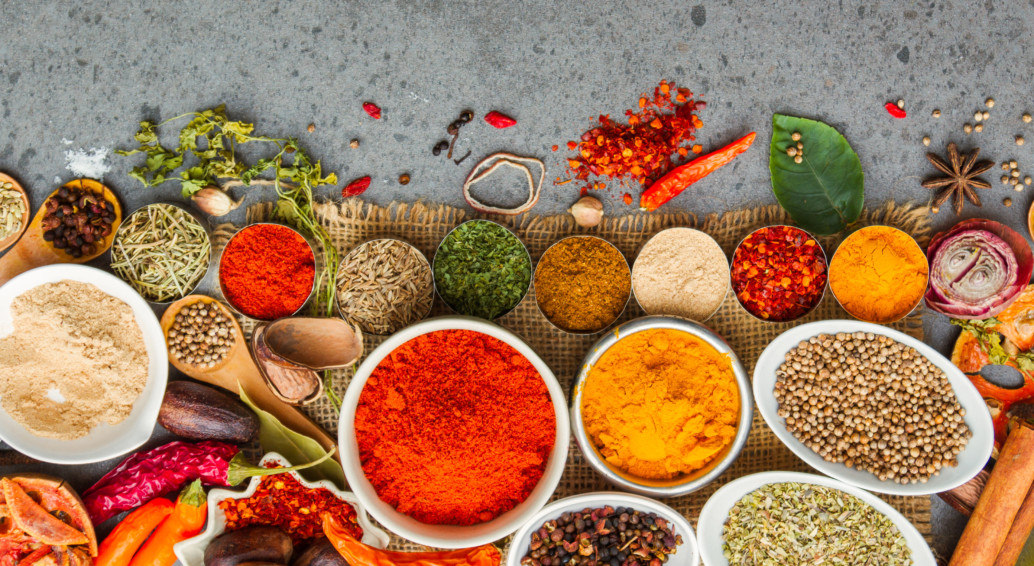Add Flavor — Not Salt

Flavoring Your Food with Spices and Herbs
Salt is an essential part of the human diet and the body, and it’s also one of the most commonly used seasonings for adding instant flavor to food. However, too much salt can cause damage. Sodium forces you to retain water, which puts extra pressure on your blood vessels and forces your heart to work harder to pump blood. So, if you find yourself frequently reaching for the salt shaker, it may be time to cut back.
Fortunately, you don’t need to sacrifice flavor when cutting back on the salt.
Herbs and Spices
A wonderful way to enhance flavor without adding salt is to use natural herbs and spices. Herbs and spices can transform a simple dish into a sensuous eating experience of lively and refreshing flavors sure to excite your taste buds.
Unfamiliar with herbs and spices? No problem! We’ve listed just a few below with tips on how and with which foods to use them.
Basil
Sweet basil is bright and pungent in taste and aroma. Basil is great for making pesto and adding to salads, sauces, meats, fish, and soups. It pairs well with carrots, eggplant, potatoes, squash, spinach, and tomatoes.
Cayenne
With its hot, peppery flavor, cayenne is frequently used in Cajun, Creole, Spanish, Mexican, Szechuan, Thai, and East Indian Recipes.
Cinnamon
One of the oldest spices known, cinnamon is derived from the inner bark of evergreen trees native to Sri Lanka, southwest India and Asia. Sweet and aromatic, cinnamon is available whole or as a ground-up powder. Cinnamon is very versatile and complements a wide variety of foods, including poultry, fruit, (particularly apples and pears), eggplant, squash, and carrot dishes.
Coriander leaf or seed
Fresh coriander leaves, also known as cilantro, bears a strong resemblance to Italian flat-leaf parsley, but with a stronger, distinct scent. The seeds, when dried, have a fragrant flavor reminiscent of both citrus peel and sage. Coriander combines nicely with beets, onions, potatoes, and lentils, and can be added to salads, salsas, soups, stews, curries, and rice dishes.
Cumin
Cumin has a powerful peppery flavoring with slight citrus overtones and is routinely used in the cuisines of Mexico, India, and the Middle East. It’s a great complement to chicken, lamb, beans, lentils, vegetables, and rice dishes, and it’s excellent in carrot and cabbage dishes.
Ginger
Ginger is fragrant, pungent, and hot. It can be used fresh, dried, or in powder form and added to curries, stews, stir-fries, and poultry.
Marjoram
A member of the mint family, marjoram is similar to oregano but less pungent. It’s often used in salads, fish, vegetables, meat, poultry, and egg dishes.
Mint
With more than 25 varieties, mint’s flavors range from cool, to sweet, to slightly menthol. It’s used in fresh in salads, marinated vegetables, tomato-based soups or stews, and is good in dips, dressings, yogurt, or lamb dishes.
Oregano
Like marjoram, oregano is also from the mint family, but stronger with an earthy, aromatic flavor. Oregano is used in many Mediterranean dishes, and excellent in tomato-based sauces and stews.
Sage
The grayish, silver-green leaves of sage have an earthy aromatic taste that is both sweet and bitter. It’s often used to flavor stuffing and is good with vegetables, cheese, and meat dishes.
Tarragon
Tarragon is a sweet aromatic herb with a slighter peppery flavor reminiscent of fennel, anise, and licorice. It’s used in soups, salads, fish, chicken, and egg dishes. And is a great complement to peas, potatoes, broccoli, carrots, and asparagus.
Thyme
The minty, tea-like flavor of thyme leaves are good with fish, vegetable, and game dishes, and often added to stocks, marinades, soups, and casseroles.